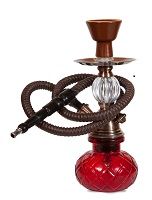Even Light Hookah Smoking Causes Lung Problems
Researchers have found that smoking a water pipe, or hookah, even only occasionally leads to a variety of pulmonary abnormalities.

Researchers have found that smoking a water pipe, or hookah, even only occasionally leads to a variety of pulmonary abnormalities.
A study conducted by Ronald G. Crystal, MD, of the Department of Genetic Medicine at Weill Cornell Medical College, and colleagues, was published in the American Journal of Respiratory and Critical Care Medicine on March 23, 2016.
The researchers’ objective was to assess the effects of smoking a water pipe on the human lung. In order complete that objective, they said they assessed “young, light-use water-pipe-only smokers in comparison to lifelong non-smokers using clinical parameters including cough and sputum scores, lung function, and chest HRCT, and biologic parameters including lung epithelial lining fluid (ELF) metabolome, small airway epithelial (SAE) cell differential and transcriptome, alveolar macrophage (AM) transcriptome, and plasma apoptotic endothelial cell microparticles (EMPs).”
A water pipe is a device for smoking flavored tobacco.
The researchers describe it with, “The tobacco is placed in a bowl surrounded by burning charcoal; when the smoker inhales, air is pulled through the charcoal and into the bowl holding the tobacco.” Not much data exists on the effects of using a water pipe, even though use is become more prevalent. The researchers hypothesized that use of the water pipe would lead to abnormalities in the lungs.
They recruited 19 self-reported nonsmokers and 21 water pipe-only smokers from the general population in New York City. The participants were healthy and baseline measurements of nicotine and cotinine levels were obtained, as well as pulmonary function test results. The two groups were comparable in ethnicity, BMI, and gender. The water pipe smokers were younger overall than the nonsmokers.
The researchers report “Cough and sputum scores were significantly higher in water pipe smokers compared to nonsmokers,” with 33% of water pipe smokers having an abnormal cough but only 5% of nonsmokers. The water pipe smokers also had “(1) lower respiratory tract and ELF-differentially present metabolites; (2) SAE, the cell population where COPD and most lung cancers are initiated - disarray of the proportions of cell types, with increased numbers of secretory and intermediate cells and decreased numbers of ciliated and basal cells and an abnormal transcriptome; (3) AM, the pulmonary representative of the mononuclear phagocyte system, functioning as the scavenger cell in the lower respiratory tract - abnormal transcriptome; and (4) pulmonary capillary endothelium - increased proportion of circulating apoptotic-derived EMPs,” according the results of the study.
The researchers conclude by suggesting that large, epidemiologic studies aimed at uncovering the harmful effects of water pipe use should be undertaken in order to combat the perception that the harmful effects of tobacco are somehow filtered out because it passes through water prior to inhalation.